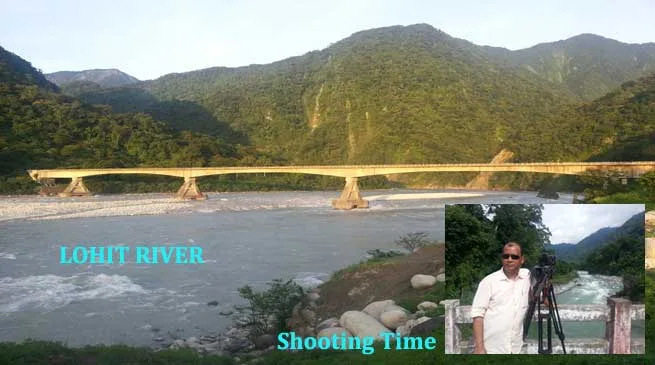
Tezu
Lohit River plays a significant role in socioeconomic aspects of the state. Being the principal river of Arunachal Pradesh, it largely contributes towards the drinking water supply, agriculture and energy needs. The river is famous for carrying out various water sport adventures.
Lohit River is the farthest east tributary of Brahmaputra River. The river originates from the Tirap Phasi Ranges located in the Eastern Tibet and then enters India via Kibitho – a small town lying at the border post. The river after entering the country travels through Mishmi Hills of Anjaw and then move towards Lohit district.
 The river travels all along from Tibet to Arunachal Pradesh for about two hundred kilometers, before merging in Brahmaputra River, Assam. Turbulent and uncontrolled are the terms used for this river. The name “Lohit” is derived because of its vigorous nature.
The river travels all along from Tibet to Arunachal Pradesh for about two hundred kilometers, before merging in Brahmaputra River, Assam. Turbulent and uncontrolled are the terms used for this river. The name “Lohit” is derived because of its vigorous nature.
Lohit River before merging into Brahmaputra River in Assam travels for about two hundred kilometers through the red laterite soils of the Lohit Basin, therefore, it is given the name “the river of blood”.
Lohit river is Arunachal Pradesh’s primary river that rises from the eastern Tibet and travels all long to the Arunachal Pradesh before merging in the Brahmaputra River. The course of Lohit River in Tibet signifies its origin or its upper course. The total length of the river is 2677 km. The river has a long course through the flat and dry regions of Tibet before it breaks into Arunachal Pradesh, India. The water current in the river remains soothing throughout the year. The geology of Lohit River points out to be the productive alluvial plains of the river basin. The surrounding towns of Lohit River are Singphos where migrants of Burma have made their home here.
Lohit River plays a significant role in socioeconomic aspects of the state. Being the principal river of Arunachal Pradesh, it largely contributes towards the drinking water supply, agriculture and energy needs. The river is famous for carrying out various water sport adventures.
 Beauty of Lohit River
Beauty of Lohit River
The valley of the Lohit is a lovely, green place. Thickly forested area for the most part, it is a dream of the botanist, as alpine vegetation gives way to sub-tropical forests. Some of the densest tropical jungles in all of India are found in this area. The rhododendrons bloom in many hues along the upper course of the river; the orchids reveal themselves in the lower course. The banks of Lohit River is indeed a treasure house of medicinal plant and herbs, and the home of Mishmi teeta, the coptis plant is known in the world over for it’s best medicinal properties.
Lohit River, Arunachal Pradesh The Mishmis hold sway in the hills, along the lower valleys of these hills the Lohit river flows. In the plains there are towns like Khamptis and the Singphos, enthusiastic Buddhists and migrants from across the Patkai hills from Burma. As the Lohit flows through, Tibetan religion gives way to animist prejudices, in turn replaced by Theravada Buddhism and then by Hindu temples as Tibet, south East Asia and the Indian sub-continent mix and combine.
Religious Significance of Lohit River
A Hindu pilgrimage known as Parshuram Kund is nestled on the lower reaches of Lohit. This holy site is very famous among the devotees. Every year on the occasion of Makar Sankranti, in the month of January more than 70,000 devotees and sadhus take holy dip in its water.
Read this also- Parshuram Kund, The Hindu Pilgrimage Site
Sports Attractions of Lohit River
The river offers sports facilities like rafting and kayaking. However, there have been very few raft and kayak expeditions on the Lohit River. The river is meant for the river rafters who are looking to have a moderate level adventure expedition. The water flow is soothing, amateurs can easily have fun crossing the medium sized rapids. Today, this river rafting activity is widely carried throughout the year and numerous tourists’ not just residents of India, but foreigners also participate to experience the pleasure to undertake kayaking in the river.













